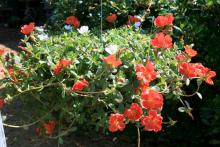Information Possibly Outdated
The information presented on this page was originally released on June 17, 2010. It may not be outdated, but please search our site for more current information. If you plan to quote or reference this information in a publication, please check with the Extension specialist or author before proceeding.
New varieties renew interest in old purslane
I read once that many flowering plants we use in our landscapes are really only one or two steps out of the ditch. This is especially true of some of the new varieties being introduced to the market.
Purslane is one of the newer plants that I have been interested in that is really an old plant. It is a succulent that thrives in high summer temperatures. Purslane has long been regarded by many as a garden weed, and I have removed many of these from the garden and landscape.
Purslane is considered a culinary herb in many parts of the world. The succulent leaves are rich in iron and can be eaten raw when young. When older, it can be cooked with other leafy vegetables like spinach. It is commonly found in Italian, Greek, Central American and Middle Eastern cuisines.
Purslane’s summer-loving qualities make the improved selections perfect for the landscape. Known botanically as Portulaca oleracae, purslane is a larger and more robust version of its relative, the popular bedding plant moss rose.
Some of the better-flowering purslanes are in the Rio series, and colors include rose, scarlet, apricot, orange, yellow and white. The flowers have a tropical look and put on a show with flowers up to 2 inches wide. The bright yellow stamens are fairly long and will move with the gentlest touch, adding more interest.
Rio purslanes are low-growing, succulent-looking annual plants. The stems are purplish-green, and the leaves are bright green. They will grow up to 8 inches tall and spread to 18 inches, so space them 12-15 inches apart in the landscape.
Rio purslanes work great in patio planters and hanging baskets, which take advantage of their spreading and trailing growth characteristics. Be sure to keep the containers a little dry.
Regular pinching will keep purslanes dense and full. Purslanes are heavy feeders that require adequate nutrition throughout the season for best flowering and growth. Water once a week with a water soluble 20-10-20 or 20-20-20 fertilizer, always following label instructions.
Purslanes like full sun. The flowers will close on cloudy days and when the plant is under stress, and they have been observed to close in late afternoon and early evening, as well.
Plant your purslanes in well-drained, amended soil. Adding 3-4 inches of compost to any landscape soil is worth the effort.
Purslane will thrive in the summer heat. It is important to allow the soil to dry out moderately between watering. As temperatures begin to cool in the fall, keep the soil on the dry side and the plant will reward you with blooms into the fall.
Purslane is a beautiful old plant that is worth trying in every Mississippi landscape.








